Live on the homepage now!
Reader Supported News
According to a source who witnessed the offer, made on board Crow’s yacht, the real-estate mogul told Justice Clarence Thomas that “since Ginni is involved in making so many Supreme Court decisions, she really should go to law school.”
After Justice Thomas informed him that she had, in fact, already gone to law school, “Crow appeared absolutely shocked,” the source said.
“Ginni went to law school?” he reportedly said. “Well, now I’ve heard everything.”
Composing himself, the billionaire added, “The offer still stands. It couldn’t hurt for her to go again. I’m offering her a full ride.”
A spokesman for Crow would not confirm or deny reports that he had also offered to send Justice Samuel Alito to law school.
READ MORE 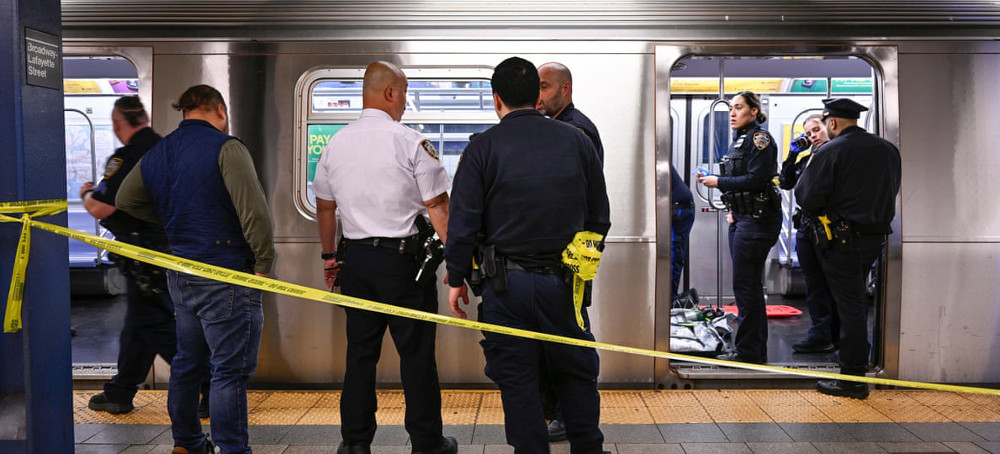 'There comes a point when all the mental health discourse begins to sound more like an alibi than a priority.' (photo: Paul Martinka/AP)
'There comes a point when all the mental health discourse begins to sound more like an alibi than a priority.' (photo: Paul Martinka/AP)
Much of the talk has been about Neely’s mental health – in large part so we don’t have to talk about our larger societal health
But Jordan Neely didn’t kill himself. He was killed, and not by his medical history. A 24-year-old white ex-marine put him in a chokehold for “some 15 minutes”, according to Juan Alberto Vazquez, a witness at the scene, and the medical examiner has ruled Neely’s death a homicide. So instead of focusing on Neely’s past, maybe we should be asking what kind of state of mind does it take to strangle a man to death in public.
I don’t know anything more about this ex-marine. I don’t even know his name, since the authorities have not released it, but I do know that Jordan Neely did not deserve to die. According to news accounts, Neely – who was unhoused and a known Michael Jackson impersonator – boarded a northbound F Train and began screaming about his distress. He was yelling about not having any food, and nothing to drink, and how he was tired and ready to go to jail. He took off his black jacket and threw it on the ground.
As discomfiting as such behavior may be for some folks to witness, there has always been a simple and non-violent New York City answer to such encounters. Move to another subway car! (The train was stopped, with the doors open.)
Instead, according to news reports, the ex-marine tackled Neely and put him in a chokehold that lasted about six minutes longer than Derek Chauvin’s knee was pressed on George Floyd’s neck, killing Floyd, in Minneapolis in 2020. He had help from a couple of other men while people were casually milling about and filming as Neely’s life came to an end.
What state of mind compels someone to use such deadly violence? Military training? Racist beliefs? Misplaced heroism? As of now, who knows, but whatever it was, it wasn’t justified. According to Vazquez, the witness, Neely hadn’t physically attacked anyone before he was tackled. And you don’t have to view the video – please don’t, it’s awful to watch – which is gruesome in its ordinariness, to see how Neely is treated not as a human being but as an object to be violently manipulated and controlled. In fact, in our society vulnerable people like Neely are almost always treated like objects to be violently manipulated and controlled.
Vasquez was also quoted as saying: “It’s fine that citizens want to jump in and help. But I think as heroes we have to use moderation.” But who’s asking for heroes in the first place? In a society as militarized and rewarding of violence as ours, there’s nothing more dangerous than someone who believes he’s a hero. (As Bertolt Brecht memorably put it: “Unhappy is the land that is in need of heroes.”)
What state of mind does it take to think that policing will solve all our social ills, only to have the NYPD, funded at $10.8bn, completely absent from the daytime death of a man in a busy subway station in the middle of Manhattan? A 2022 investigation by the Guardian and the University of Washington found that between 2015 and 2020, deaths among people living without housing in 20 urban areas in the United States rose by 77%. Who exactly do the police protect?
Beyond state of mind, we must also think about our state. In what kind of state can this 24-year-old ex-marine be taken in for questioning by the police, only to be released the same day? Had the races of assailant and victim been reversed, does anyone think the situation would be the same? Do you really think we still wouldn’t know his name if it sounded like a Muslim name?
Based on what he was saying, what Jordan Neely wanted was some food to eat and a place to sleep. What does that say about us? What kind of state do we live in where poverty is not only considered a badge of shame but also a source of fear? What kind of state do we live in where we spend more money hiding unhoused people from our eyes than finding them affordable housing? What kind of state do we live in where talk of mental health concerns is everywhere but so little of it is in invested with solutions. There comes a point when all the mental health discourse begins to sound more like an alibi than a priority.
Jordan Neely’s killer must be arrested and face justice. Of that there is no doubt, just as there’s no doubt that in the near future, we will be bombarded with every mental health episode and every police encounter Neely ever had. Through it all, I expect the focus will return, with deadly repetition, to Neely’s mental health. Much of it will be sensationalist and driven by fearmongering, while some it might even consider the ways that endemic poverty, lack of housing, various forms discrimination, social and family trauma are all connected to an individual’s mental health. But what will largely go missing is this way we have of talking about an individual’s mental health precisely so that we don’t have to talk about our larger societal health.
Because if we looked into it honestly, what we’d see is a society enthralled by its own hierarchies and beholden to its traditions of violence. What we’d see is a society in desperate need of healing.
READ MORE 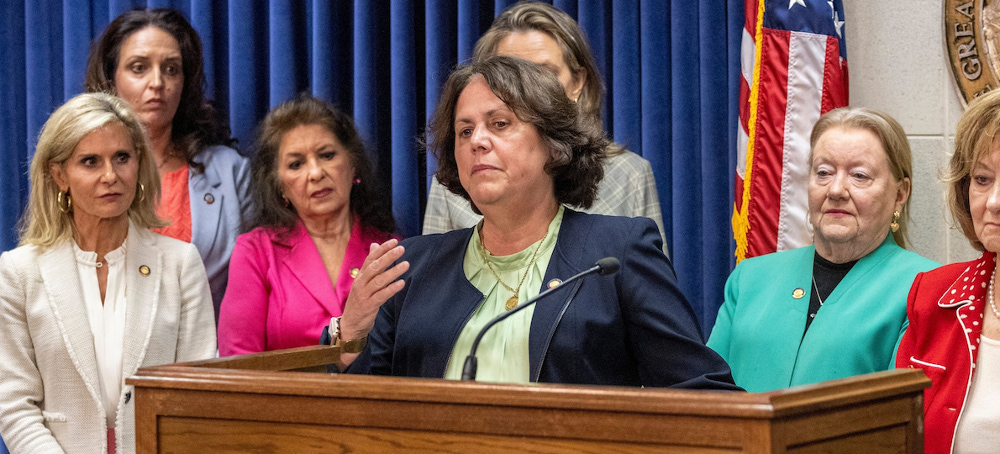 House Speaker Pro Tempore Sarah Stevens (R-Surry) speaks as Republican lawmakers announce a deal to restrict abortion after the first trimester of pregnancy on Monday, May 2, 2023, in Raleigh, N.C. (photo: Travis Long/AP)
House Speaker Pro Tempore Sarah Stevens (R-Surry) speaks as Republican lawmakers announce a deal to restrict abortion after the first trimester of pregnancy on Monday, May 2, 2023, in Raleigh, N.C. (photo: Travis Long/AP)
GOP lawmakers are hoping to exploit a new veto-proof supermajority in a state that has become a critical access point for abortions
The new measure was unveiled just days after proposed bans fizzled last week in two other conservative states — a near-total ban in South Carolina and a six-week ban in Nebraska — with opposition coming from some Republican women and others in the party amid fears of a growing political backlash prompted by the fall of Roe v. Wade.
The 12-week ban won passage late Wednesday in North Carolina’s GOP-dominated state House, 71-46. The proposal is expected to pass in the Senate as early as Thursday, and then head to the desk of Governor Roy Cooper (D), who has vowed to veto any new abortion restrictions.
Republicans, who hold a veto-proof supermajority in the legislature, have said they would seek to enact the bill over Cooper’s objections.
But the vote Wednesday night showed potential cracks in the GOP strategy when one Republican failed to cast a vote, leaving the final tally one vote shy of the number needed to override Cooper’s veto.
Female Republican lawmakers took a leading role this week in introducing the legislation at a surprise news conference, which capped months of closed-door deliberations among Republicans, many of whom had been pushing for a six-week ban. The lawmakers repeatedly claimed that the 12-week ban would be widely popular with residents of North Carolina, describing the proposal as a “mainstream” approach to the issue.
“We [looked] at what most North Carolinians have said. This is where most of them come down,” said Republican state Sen. Joyce Krawiec, adding that there was “a lot of discussion, and a lot of back and forth.”
Another lawmaker, Rep. Sarah Stevens (R), the House Speaker pro tempore, referred to the bill as “pro-woman.”
Democratic leaders disputed the idea that the proposal would be popular with the public.
“Republican leadership has once again schemed behind closed doors and silenced the voices of both members of the public and members of the state legislature in order to force a harmful abortion ban down our throats,” state Sen. Dan Blue and Rep. Robert Reives, who are both Democrats, said in a statement. “North Carolinians believe in freedom, including the freedom to decide if and when to start a family.”
The vast majority of abortions in the country are performed earlier than the limit North Carolina lawmakers will consider. In 2020, roughly 93 percent of abortions were performed at or earlier than 13 weeks of pregnancy, according to the Centers for Disease Control and Prevention.
The legislation would establish exceptions for rape and incest through 20 weeks, along with an exception for lethal fetal anomalies through 24 weeks. The proposal also includes an exception for the life of the mother.
While Cooper has repeatedly vetoed abortion restrictions in the past, this weeks events underscored a new dynamic in Raleigh, where last month a decision by a House Democrat to switch parties handed Republicans a veto-proof supermajority, which could give them the power to deliver on antiabortion legislation for the first time in years.
North Carolina, where abortion is currently legal until 20 weeks of pregnancy, has become a destination for people seeking the procedure in the wake of the Supreme Court decision in June that overturned Roe v. Wade, triggering strict bans across the South. In the first two months after the landmark ruling, North Carolina experienced a greater spike in abortions than any other state.
Across the country, conservatives in the months since the Supreme Court overturned Roe have pushed GOP leaders to seize the opportunity to enact strict bans. But voters have repeatedly demonstrated their strong support for abortion rights, striking down antiabortion amendments even in conservative states such as Kentucky and Kansas.
The 2022 midterms, in which a number of Democrats won competitive races after making abortion rights a central issue, were widely viewed as a danger sign for Republicans.
North Carolina Republicans said Tuesday that the proposal would be coupled with millions of dollars in additional spending for child care, paid parental leave for teachers and state employees, and foster care. The lawmakers said they would also increase funding for crisis pregnancy centers, organizations that aim to dissuade women from having abortions.
Rep. Tricia Cotham, the lawmaker whose party switch sealed the Republican supermajority in North Carolina, has expressed support for abortion rights in the past but has not said how she would vote as a Republican. On Wednesday night, she voted for the 12-week ban.
The Republican lawmakers who presented the plan on Tuesday said they were confident they could win support from some Democrats, several of whom have a history of voting for antiabortion legislation.
Earlier this year, every Democratic member in the state legislature signed onto a bill that would codify Roe into law. The legislation was meant as a showing of Democratic unity, though it was doomed from the start in the Republican-dominated legislature.
But in the days after, one Democratic lawmaker told The Post he hadn’t ruled out voting for restrictions on abortion.
“I lay down with it, I wake up with it,” state Rep. Garland Pierce (D), who leads the congregation at Bright Hopewell Missionary Baptist Church in Laurinburg, N.C., said at the time. “When you reach deep down you want to be sure you’re doing the right thing.”
Pierce voted against the 12-week ban on Wednesday.
NC Values Coalition, one of the leading antiabortion groups in North Carolina, had initially drafted a six-week abortion ban “as a starting point,” the group’s executive director, Tami Fitzgerald, previously told The Post.
In a statement issued after Tuesday’s news conference, the group said the proposal fell short of the group’s long-term goals. The group only supports abortion when it is necessary to save the life of the mother.
“NC Values believes life begins at conception, and that life is a human right. Although the General Assembly opted to limit abortion at 12 weeks, we are grateful more babies will be protected by moving the limit from 20 weeks back to 12 weeks,” said Fitzgerald.
READ MORE 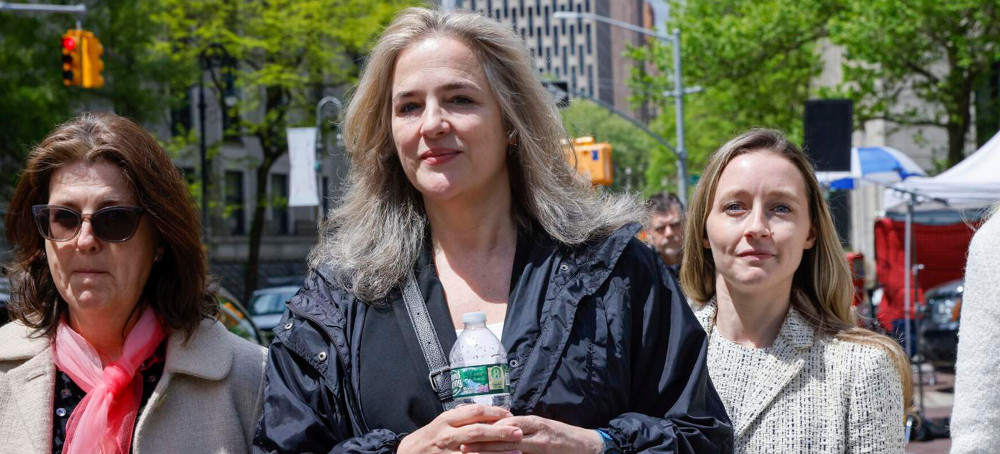 Natasha Stoynoff walks outside federal court Wednesday, May 3, 2023, in New York. She testified that Donald Trump forcibly kissed her at his Florida mansion when she went there in 2005 to interview him and his then-pregnant wife Melania Trump. (photo: Stefan Jeremiah/AP)
Natasha Stoynoff walks outside federal court Wednesday, May 3, 2023, in New York. She testified that Donald Trump forcibly kissed her at his Florida mansion when she went there in 2005 to interview him and his then-pregnant wife Melania Trump. (photo: Stefan Jeremiah/AP)
She testified in E. Jean Carroll's defamation and battery case against Trump.
Carroll, who brought the lawsuit in November, alleges that Trump defamed her in a 2022 Truth Social post by calling her allegations "a Hoax and a lie" and saying "This woman is not my type!" when he denied her claim that Trump raped her in a Bergdorf Goodman dressing room in the 1990s.
The former Elle magazine columnist added a charge of battery under a recently adopted New York law that allows adult survivors of sexual abuse to sue their alleged attacker regardless of the statute of limitations. Trump has denied all allegations that he raped Carroll or defamed her.
Former People writer Natasha Stoynoff told the jury she was at Mar-a-Lago in late 2005 to write an article on Donald and Melania Trump's first wedding anniversary, when Trump asked to show her a room in the estate.
"I followed him and we went in through these back doors and down the hall and turned right into a room," Stoynoff said. "I'm looking around, I'm thinking, 'Wow, really nice room,' wondering what he wants to show me, and I hear the door shut behind me."
Stoynoff said she had interviewed Trump on a number of occasions as part of her assignment on the "Trump beat" for People. She testified that Trump asked her into the room while Melania was changing clothes in preparation for their interview outside.
"By the time I turn around, he has my hands on my shoulders and he pushes me against the wall and he starts kissing me," Stoynoff testified. She said that she tried to shove him away.
"He came toward me again and I tried to shove him again," Stoynoff said. "He was kissing me and he was against me, holding my shoulder back."
She testified that she said no words.
"I couldn't. I tried. I was just flustered and shocked. No words came out of me," Stoynoff told the jury.
"Did you tell him to stop?" Carroll's attorney, Michael Ferrara, asked. "I couldn't," Stoynoff answered. She said the encounter ended when a butler entered the room.
Stoynoff described herself as "ashamed and humiliated at what had happened," and testified she said nothing about it to her bosses at People because she didn't want to cause trouble at the magazine.
She said she first decided to tell her story after she saw the infamous "Access Hollywood" tape that surfaced during the 2016 presidential campaign, on which Trump is overheard boasting to then-host Billy Bush about grabbing and kissing women without consent.
"You know, I'm automatically attracted to beautiful -- I just start kissing them. It's like a magnet. Just kiss. I don't even wait," Trump says on the tape, which was played for the jury. "And when you're a star they let you do it ... You can do anything."
"Whatever you want," another voice on the tape is heard saying.
"Grab them by the p----," Trump says. "You can do anything."
After Stoynoff made her allegation in 2016, Trump denied her claim by saying "Look at her. You tell me what you think. I don't think so," in a response that Carroll's attorneys said echoed his assertion that Carroll was "not my type."
On cross-examination, Trump attorney Joe Tacopina asked Stoynofff if she had a legal claim against Trump. She said no.
Stoynoff is one of two women who the court has ruled are allowed to testify about prior alleged assaults by Trump. On Tuesday, Jessica Leeds told jurors that Trump groped her during a flight to New York in 1979, in what Carroll's attorneys said showed a pattern of behavior on Trump's part.
Leeds, who first made her allegations to The New York Times just before the 2016 presidential election, testified that she was seated next to Trump in the first-class section, "when all of a sudden Trump decided to kiss me and grope me."
"It was when he started putting his hand up my skirt, that gave me a jolt of strength," testified Leeds, who said she freed herself and went "storming back to my seat in the back of coach."
Trump has denied the allegations.
Earlier Wednesday, Tacopina told Judge Lewis Kaplan that Trump will not mount a defense in the case.
Tacopina told the judge that he had decided not to call an expert witness that had been expected to testify for the defense. "We're not going to move forward," Tacopina said.
The judge told the jury to expect to get the case "early next week."
Carroll's sister, Cande Carroll, testified Wednesday afternoon that she found out about her sister's alleged rape in 2019 when Carroll sent her an email containing a link to an excerpt of Carroll's 2019 book that contained the rape allegation.
That she found out about it that way was hardly surprising, she said, because she and her older sister "just didn't talk about those things."
On cross-examination, the younger Carroll testified that she and Carroll had a close relationship in the 1990s when the alleged rape occurred.
"You talked almost daily?" defense attorney Perry Brandt asked. "Most days," Carroll responded, before Brandt asked her to affirm that the first she had heard of the alleged sexual assault by Trump was in 2019.
Earlier Wednesday, a psychologist testified that Carroll continued to shop at Bergdorf Goodman after the alleged attack because "she didn't feel that Bergdorf Goodman raped her."
"She didn't blame the store. She blamed herself," said Dr. Leslie Lebowitz, who evaluated Carroll for the case.
The defense suggested the fact that Carroll continued to shop at Bergdorf's, saved the dress she wore the evening of the alleged assault, and watched Trump's reality television show, "The Apprentice," were behaviors out of step with the deep trauma Carroll said she suffered.
Lebowitz pushed back against the inference from the defense that Carroll's rape claim against Trump could not be true because she did not act like it actually happened.
"I think anywhere Ms. Carroll could see evidence that she was negatively affected by what happened, she would fight against it. So to not go back into Bergdorf's would have been really obvious, given how much she loved that store," Lebowitz said.
The same holds true for the dress, Lebowitz said.
"I think that she loves clothes and that was the most expensive dress she'd ever brought," Lebowitz said. "It would have been impossible to avoid the realization that she was that negatively affected."
As for watching "The Apprentice," Lebowitz said there was excitement about the show in Carroll's professional and social circles. To not watch would have forced her to reveal why.
On cross-examination, defense attorney Chad Seigel asked Lebowitz if her diagnosis concluded that Carroll had been raped.
"You're not offering an opinion in this case whether Ms. Carroll was raped?" Seigel asked.
"I'm not," Lebowitz replied.
Lebowitz said that Carroll did meet some of the criteria for post-traumatic stress disorder, including exhibiting signs of memories affected by trauma. She described a moment during her evaluation when Carroll "began to squirm in her seat" because she appeared to be "re-experiencing" elements of the alleged assault.
She also told the jury that rape victims commonly experience self-blame.
During her testimony earlier this week, Carroll said, "I was ashamed. I thought it was my fault."
"Why did you think it was your fault, Ms. Carroll?" her attorney, Michael Ferrara, asked.
"Because I was flirting with him and laughing and having one of the great times. It was high comedy. It was funny," Carroll said.
The nine-member jury of six men and three women is weighing Carroll's defamation and battery claims and deciding potential monetary damages.
Carroll's lawsuit is her second against Trump related to her rape allegation.
She previously sued Trump in 2019 after the then-president denied her rape claim by telling The Hill that Carroll was "totally lying," saying, "I'll say it with great respect: No. 1, she's not my type. No. 2, it never happened. It never happened, OK?" That defamation suit has been caught in a procedural back-and-forth over the question of whether Trump, as president, was acting in his official capacity as an employee of the federal government when he made those remarks.
If Trump is determined to have been acting as a government employee, the U.S. government would substitute as the defendant in that suit -- which means that case would go away, since the government cannot be sued for defamation.
This month's trial is taking place as Trump seeks the White House for a third time, while facing numerous legal challenges related to the Jan. 6 Capitol attack, his handling of classified material after leaving the White House, and possible attempts to interfere in Georgia's 2020 vote. Fulton County District Attorney Fani Willis said last week she would decide whether to file criminal charges against Trump or his allies this summer.
READ MORE 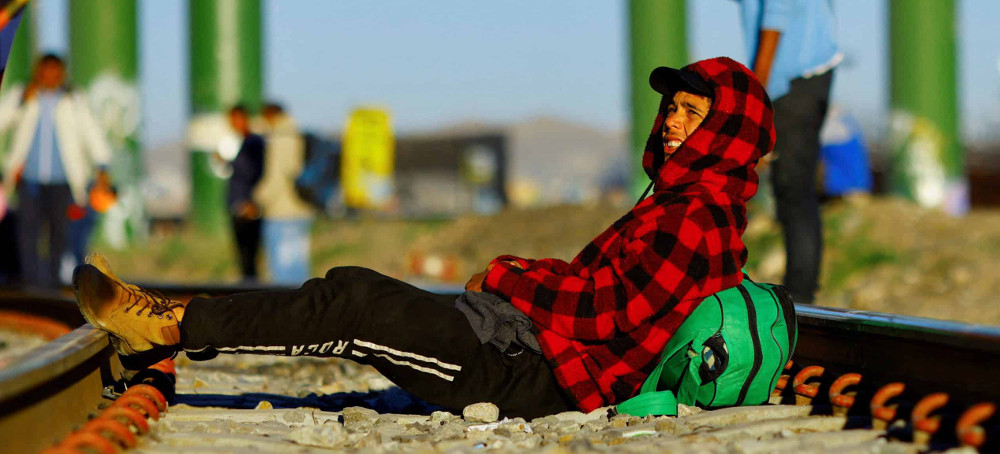 A Venezuelan migrant in Ciudad Juarez on the U.S.-Mexico border. (photo: José Luis González/Reuters)
A Venezuelan migrant in Ciudad Juarez on the U.S.-Mexico border. (photo: José Luis González/Reuters)
Agreement designed to curb increase of people arriving into US marks dramatic precedent for two countries, experts say
Under the agreement announced in a joint statement Tuesday, Mexico will continue accepting migrants from Venezuela, Haiti, Cuba and Nicaragua who are turned away from the US.
The agreement comes as the US is set to end a pandemic-era policy known as Title 42 next week, which allowed authorities to quickly return migrants to Mexico, a move expected to produce a surge of people attempting to cross the border.
The announcement suggests that an accord which began in January, when Mexico agreed to accept 30,000 migrants per month from those four countries who did not follow a legal pathway, has become more permanent, cementing what analysts say is a significant policy shift on migration between both nations.
“The status quo on the ground won’t change much, but from a legal perspective this is a seismic shift,” said Aaron Reichlin-Melnick, policy director at the American Immigration council, on Twitter. “At no point in US history has there ever been another country which would take large numbers of deportations from the US of people who aren’t nationals of that country.”
In the long term, the change means the United States could increasingly rely on Mexico to accept deportees from countries other than Mexico, piling further pressure on border cities already struggling with large migrant populations.
“It sets a very delicate precedent,” said Martha Bárcena, a former Mexican ambassador to the United States. “That would put unnecessary pressure on Mexico. And not political pressure: you just have to look at the border to know that we can’t handle so many people.”
The changes come as migration to the US has surged in recent years, with American authorities making nearly 2.6 million apprehensions last year at its southern border. In Mexico, authorities detained almost half a million migrants last year, a 44% increase from 2021.
President Biden has faced pressure from Republicans to address the migrant surge: on Tuesday, the Pentagon announced it would be sending an additional 1,500 active-duty troops to the southern border.
But conditions for migrants in Mexico have become increasingly dire, with migrants facing not just extortion and violence from criminals but also abuse from authorities: a fire at a detention center in Ciudad Juárez in March killed 40 migrants.
“We had the fire in Ciudad Juárez, but it appears that we have learned nothing – the border cities are overwhelmed,” said Bárcena. “We can’t receive so many people to resolve a political problem in the United States.”
The White House has taken additional steps to dissuade migrants from even reaching Mexico, including the announcement last week that it would create regional processing centers in Latin America to screen migrants who could be eligible to enter the US legally. The Biden administration has also agreed to accept up to 100,000 migrants from Honduras, Guatemala, and El Salvador under a family reunification program.
But it is still unclear when and how these policies will be implemented. Meanwhile, tens of thousands of migrants are already on their way to Mexico and the US after having crossed through the deadly Darién Gap between Panama and Colombia.
The number of migrants who have crossed the Darién in the first three months of this year increased sixfold to more than 87,000 compared to the same period in 2022, according to figures from the Panamanian government, most of them headed to the US border.
“Across the board, no matter how you look at it, whether it’s children, women, families, single adults, these numbers are increasing,” said Dana Graber Ladek, head of mission for the UN International Organization for Migration in Mexico. “This is particularly concerning given the complex environment in Mexico.”
READ MORE  Jair Bolsonaro said his mobile phone and that of his wife had been seized during the raid. (photo: Adriano Machado/Reuters)
Jair Bolsonaro said his mobile phone and that of his wife had been seized during the raid. (photo: Adriano Machado/Reuters)
Police have searched the home of former President Jair Bolsonaro in the Brazilian capital, Brasilia, as part of an investigation into his Covid vaccination records.
Officers seized the mobile phone of the former president and that of his wife and arrested some of his close aides as part of the operation.
Mr Bolsonaro has denied any wrongdoing.
The former president is a vocal opponent of Covid vaccinations, who repeatedly spread false information about the vaccine and its alleged side effects.
While he had always said that he would not get the vaccine, he had refused to make his vaccination record public, arguing that it contained sensitive private data.
But an official in the new government of his successor, Luiz Inácio Lula da Silva, ruled that the information was in the public interest.
The record showed that Mr Bolsonaro had had a vaccine in 2021 but police think the record may have been forged and launched the investigation which led to Wednesday's raid.
According to federal police, "false data" was inserted into the Covid-19 vaccination records held by the Brazilian ministry of health so that the individuals whose vaccination status had been changed would be able to get the vaccination certificates necessary to enter the United States
Speaking after the raid, Mr Bolsonaro denied tampering with any records. "For my part, there was nothing falsified," he told reporters.
He also denied having had a Covid jab: "I didn't take the vaccine. Period."
The false data was allegedly inserted in the records between November and December of last year, when Mr Bolsonaro was still president.
Mr Bolsonaro travelled to Florida at the end of December, just days before his rival, Luiz Inácio Lula da Silva, was sworn into office.
The US has not commented on what visa the then-president entered the country on or what, if any, vaccination records he provided at the time.
Since his return to Brazil on 30 March, Mr Bolsonaro has had to appear before police on two occasions to testify in two separate investigations.
One is examining his alleged role in the storming of the Brazilian Congress by his supporters in January. He is also being investigated over whether he tried to illegally import and keep millions of dollars' worth of jewellery he and his wife were given by Saudi Arabia in 2019.
READ MORE 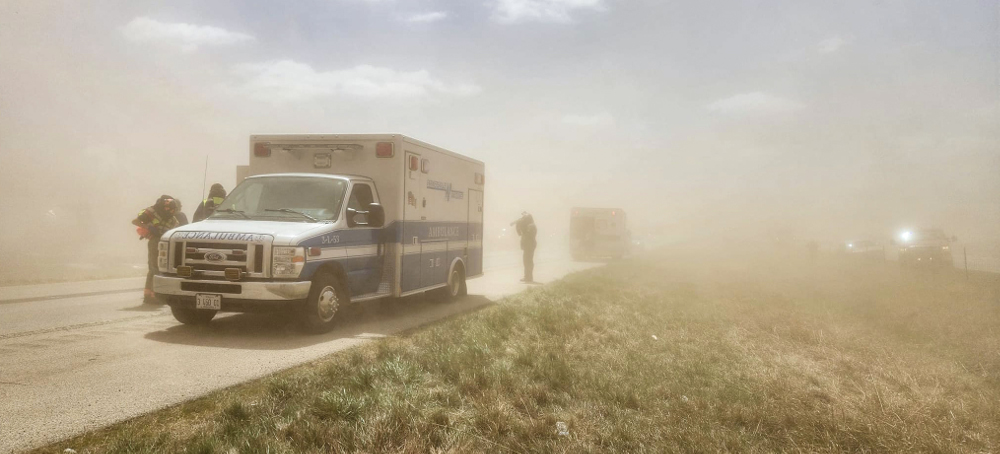 Ambulances and firefighters at the scene of car pileup as a result of a dust storm on I-55 in Illinois on Monday. (photo: Nathan Cormier/NBC News)
Ambulances and firefighters at the scene of car pileup as a result of a dust storm on I-55 in Illinois on Monday. (photo: Nathan Cormier/NBC News)
Fast-moving winds can suddenly whip dirt and debris into the air, leading to fatal accidents. It's an issue worsened by drought, climate change and land management.
The Illinois storm caused a 72-car pileup after high winds whipped dust from recently tilled farms into a cloud that caked the insides of cars. At least 37 people were hospitalized.
Such storms often lead to accidents, many of them fatal. There is no definitive tracking of dust storm prevalence nationally, but a March study published by the Bulletin of the American Meteorological Society found 272 fatalities attributed to dust storms between 2007 and 2017.
“This problem is heavily underestimated, understudied and underreported,” said co-author of the study Daniel Tong, a research scientist at the National Oceanic and Atmospheric Administration and an associate professor at George Mason University.
Dust storms are created when fast-moving winds kick up dirt and debris into the air, creating a dark swirling mass that can be difficult to see through or breath in. They become particularly dangerous over roadways and can obstruct a driver’s vision. The advice from authorities and car safety groups like AAA is to pull off the roadway entirely when this happens, turn off the lights to avoid having others follow you in the darkness, and buckle your seat belt until it passes.
Drought, climate change and land management practices are making dust storms more prevalent in some U.S. regions, like the Southwest. One study found that the frequency of large dust storms in the Southwest more than doubled from 1990 to 2011.
More rainfall could be a factor decreasing risk in some areas, like the eastern U.S., but experts said flash droughts and heavy agricultural use mean that localized dust storms can swirl with little notice in these places and surprise drivers unfamiliar with these storms’ hazard.
“A dust storm is not only a weather phenomenon in the desert, it can happen anywhere in the country,” Tong said. “It can come from a farm, it can come from a school playground, even people’s backyards. If the land is not covered by vegetation and there’s a strong wind, that can be a dust storm.”
The states with frequent dust storms and the largest number of deaths are Texas, New Mexico, Arizona and California, according to the Meteorological Society report. Illinois was an outlier. The state counted only two dust fatalities — both in 2017.
“We had a prolonged event of dry warm weather for early April that dried off our top soil down to eight inches — dried it to dust,” said Trent Ford, the Illinois State Climatologist. “But the bottom layer retained moisture and Monday’s really strong winds made the top layer airborne. It was really an unfortunate location along one of the busiest highways.”
Tom Gill, a professor in the environmental science and engineering program at the University of Texas at El Paso, said the key ingredients for dust are typically drought, land disturbance and wind.
Farm fields without irrigation are a common source of dust storms.
Ford said he didn’t think climate change was necessarily a factor in Monday’s crash, as it had largely driven wetter planting seasons and flooding in Illinois. But he said land management issues were a particular problem in Illinois and could have contributed to the issue. He did note that climate change was certainly a factor for dust storms in the West, where they predominantly occur.
Shrinking or empty lakes in Western states have been significant contributors of dust pollution.
Last fall, the Great Salt Lake’s water levels fell to its lowest on record, exposing much of the lakebed and creating conditions for storms of dust — laden with toxic metals — that now threaten the 2 million people living nearby.
In California, Los Angeles Department of Water and Power ratepayers have spent at least $2.5 billion controlling dust emissions at Owens Lake, which was drained by the utility and was once the largest human-caused source of dust in the U.S.
Dust can have health consequences. Exposure to dust particles can cause respiratory disease, cardiovascular issues and fungal infections. Dust can carry heavy metals and other toxins into people’s homes and lungs. Any dust-related deaths caused by disease or infection were not included in the Bulletin of the American Meteorological Society study.
“If you breathe particles of stuff in the air and it gets into your respiratory tract, in your lungs, it’s going to cause irritation whether it’s toxic or not,” Gill said. “It adds to the burden of air pollution.”
While dust storms are becoming more prevalent in the Southwest, other regions will likely experience fewer dust storms as overall precipitation continues to increase. But a threat could still exist. Gill and other researchers are concerned about the impact of flash droughts — when extreme temperatures rapidly parch the landscape during periods of variability — and how those patterns could affect areas of the U.S. that are more wet, in general, and have heavy agricultural use.
Dust storms have been responsible for other fatal highway pileups. According to Tong’s research, there were six such crashes involving semi-trucks between 2007 and 2017 with five occurring in New Mexico and Arizona along two stretches of Interstate 10.
States have addressed the storms along that corridor with dust mitigation efforts, something more states should undertake, Tong said.
“Now is the time to think about adopting some new land management and air quality measures that have been in practice in some Western states,” he said. “For example, we need to consider air quality and health impacts of agricultural tilling. When you till, you should observe weather forecasts and maybe consult some experts about the proper time and check whether the land is very dry.”
Follow us on facebook and twitter!
PO Box 2043 / Citrus Heights, CA 95611



No comments:
Post a Comment
Note: Only a member of this blog may post a comment.